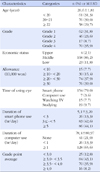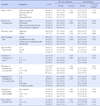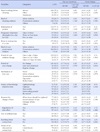Abstract
Purpose
The purpose of this study was to examine dry eye syndrome and ocular fatigue according to the status of contact lens wearing and management among female university students.
Methods
The subjects were 195 female university students wearing contact lenses. Ocular Surface Disease Index (OSDI) and Virtual Reality Symptom Questionnaire (VRSQ) were used to determine the level of dry eye syndrome and ocular fatigue. The SPSS/WIN 21.0 program was used for analysis of data.
Results
Significant differences in the level of dry eye syndrome were observed according to the period of case solution change (F=3.36, p=.037) and the reasons for the change of lens (F=4.56, p=.004). In ocular fatigue, significant differences were observed according to the price of lens (F=3.53, p=.031), rinse in storing lens in a case (t=-2.57, p=.011), and learning about contact lens (t=-2.01, p=.046). A significant positive correlation was observed between dry eye syndrome and ocular fatigue in the subjects.
Figures and Tables
References
1. Chu BS, Mah KJ, Hwang JH. Contact lens market trend of Korean optometric clinics in 2010. Korean J Vis Sci. 2010; 13(3):225–234.
2. Kim DH, Kim JS, Mun JH. The status of soft contact lens wear in college students in Korea. J Korean Ophthalmic Opt Soc. 2004; 9(2):233–239.
3. Shin JC. The status of care for soft contact lens and periodic examination. J Korean Ophthalmic Opt Soc. 2000; 5(2):107–113.
4. Choi TH, Kim HM, Cha HW, Kim JC, Kim MS, Lee HB, et al. Research on the current status of contact lenses in Korea. J Korean Ophthalmol Soc. 2004; 45(11):1833–1841.
5. Dong EY, Kim EC. The Korean Contact Lens Study Society. Results of population-based questionnaire on the symptoms and life styles associated with contact lens. J Korean Ophthalmol Soc. 2001; 42(1):30–35.
6. Park SJ, Lee SM, Kim MK, Han YK, Wee WR, Lee JH. Cosmetic contact lens-related complications: 9 case. J Korean Ophthalmol Soc. 2009; 50(6):927–935.
7. Song JS, Lee H, Kim JW, Chang MH, Ha SK, Kim HM. The effect of cheap tinted contact lenses on corneal swelling and ocular surface inflammation. J Korean Ophthalmol Soc. 2008; 49(12):1888–1893.
8. Lee KJ. Bacterial Contamination of Contact Lens Salines Used by Contact Lens Wearers. Korean J Vis Sci. 2003; 5(1):53–65.
9. Lee KJ, Kim HJ, Choi BK, Kim KD. Microbial contamination and associated factors in saline solution used by contact lens wearers. Korean J Vis Sci. 2011; 13(2):157–168.
10. Bullock JD, Elder BL, Khamis HJ, Warwar RE. Effects of time, temperature, and storage container on the growth of fusarium species: Implications for the worldwide fusarium keratitis epidemic of 2004-2006. Arch Ophthalmol. 2011; 129(2):133–136.
11. Yung MS, Boost M, Cho P, Yap M. Microbial contamination of contact lenses and lens care accessories of soft contact lens weares (university students) in Hong Kong. Ophthalmic Physiol Opt. 2007; 27(1):11–21.
12. Kim DP, Lee KJ, Eom JH, Choi SM, Doo HY, Park MJ, et al. Ocular symptoms of Contact Lens Wearers identified by a dry eye survey. Korean J Vis Sci. 2011; 13(3):213–223.
13. Lee KJ, Buyn JW, Mun MY, Leem HS. The relationship between habitual patient-reported symptoms and signs in the soft contact lens wearers. J Korean Ophthalmic Opt Soc. 2008; 13(3):19–28.
14. Kim MJ, Jang WY, Hwang HK. The comparative analysis for the progression of dry eyes caused by wearing soft contact lenses (SCL) and cosmetic soft contact lenses (C-SCL). J Korean Ophthalmic Opt Soc. 2011; 16(4):375–381.




 PDF
PDF ePub
ePub Citation
Citation Print
Print







 XML Download
XML Download